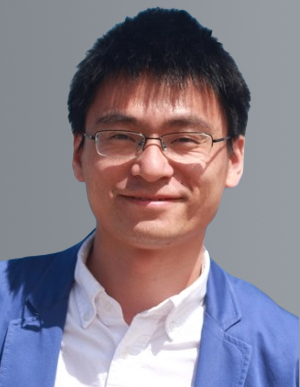

中国科学院生物物理研究所,认知科学与心理健康全国重点实验室,研究组长
2004 - 2008 吉林大学物理学院,物理学学士
2008 - 2013 北京大学定量生物学中心,凝聚态物理学博士
2013 - 2020 哈佛大学物理系及脑科学中心,博士后
2020 - 至今 中国科学院生物物理研究所,研究员,博士生导师
2023 - 至今 中国科学院大学,岗位教师
1. 国家自然科学基金委面上项目:果蝇幼虫中枢嗅觉神经编码的结构与演化(32171006,2022-2025),主持
2. 国家自然科学基金委重大项目:果蝇幼虫的运动控制机制与仿生智能机器人(T2293720,2023-2027),项目骨干
3. 中国科学院国际伙伴计划:解析嗅觉感知与学习的神经计算基础(080GJHZ2022036FN,2023-2025),主持
大脑的核心特征在于其通过多样化的神经元组建成复杂网络,用以处理信息并调控行为。我们实验室聚焦于探索生物神经系统在网络层面的定量规律。当前研究主要集中以下三个方向:
1. 神经编码
神经系统通过神经元群体活动对信息进行表征和加工。受内外部环境制约,生物神经编码展现出独特且普遍的性质。我们通过研究果蝇嗅觉神经编码的形成、变换及发育,从统计性质、动力学和神经计算等多个角度探索生物神经编码的基本规律,并将这些发现应用于类脑算法和仿生系统的开发。
2. 环路组装
神经网络结构在很大程度上决定了神经系统的性质和功能,其形成受到发育进程、物理限制与神经活动等多因素共同作用。我们通过分析线虫与果蝇的神经连接组,追踪其网络发育与演化的过程,从多尺度视角揭示结构形成的关键机制,并建立神经环路组装的动态模型。
3. 运动控制
运动控制是神经系统最核心的输出功能之一,行为是信息处理对环境产生反馈的最终形式。运动行为的复杂性源于神经系统、身体结构与外部环境之间的相互作用。我们综合运用生物力学、控制理论、神经科学与虚拟现实技术,研究果蝇的运动控制机制,旨在揭示生物运动控制的基本原理,为仿生机器人设计提供理论基础与新思路。
1. Liang X*, Ding Y, Yuan Z, Han Y, Zhou Y, Jiang J, Xie Z, Fei P, Sun Y, Jia P, Gu G, Zhong Z, Chen F*, Si G*, Gong Z*. "Mechanics of soft-body rolling motion without external torque" Phys. Rev. Lett. 134.19 (2025): 198401 (* co-corresponding author).
Also see the FOCUS article 'Insect Larvae Inspire Rolling Robots' in Physics 18 (2025): 104.
2. Wu Y, Zhang R, Li D, Qi K, Chai Y, Shen C, Si G*, Wen Q*. "Whole Brain Imaging of Larval Zebrafish during Rheotaxis" Progress in Biochemistry and Biophysics 49.9 (2022): 1731-1740 (* co-corresponding author).
3. Eschbach C*, Fushiki A, Winding, M, Afonso B, Andrade I, Cocanougher B, Eichler K, Gepner R, Si G, Valdes-Aleman J, Fetter R, Gershow M, Jefferis G, Samuel A, Truman J, Cardona A*, Zlatic M*. "Circuits for integrating learned and innate valences in the insect brain" Elife 10 (2021): e62567 (* co-corresponding author).
4. Si G#, Kanwal J#, Hu Y, Tabone C, Baron J, Berck M, Vignoud G, Samuel A. "Structured odorant response patterns across a complete olfactory receptor neuron population" Neuron 101.5 (2019): 950-962 (# co-first author).
Also see the Previews article "Order in Odors: A Power Law Structures the Encoding of Stimulus Identity and Intensity" in Neuron 101.5 (2019): 768-770.
5. Zhang X, Si G, Dong Y, Chen K, Ouyang Q, Luo C*, Tu Y*. "Escape band in Escherichia coli chemotaxis in opposing attractant and nutrient gradients" Proc. Natl. Acad. Sci. U.S.A., 116.6 (2019): 2253-2258 (* co-corresponding author).
6. He L, Si G, Huang J, Samuel A, Perrimon N. "Mechanical regulation of stem cell differentiation through stretch-activated Piezo channel" Nature 555.7496 (2018): 103.
7. Li Z, Cai Q, Zhang X, Si G, Ouyang Q, Luo C*, Tu Y*. "Barrier crossing in Escherichia coli chemotaxis" Phys. Rev. Lett. 118.9 (2017): 098101 (* co-corresponding author).
Also see the SYNOPSIS article 'Racing Bacteria' in Physics.
8. Berck M, Khandelwal A, Claus L, Hernandez-Nunez L, Si G, Tabone C, Li F, Truman J, Fetter R, Louis M*, Samuel ADT*, Cardona A*. "The wiring diagram of a glomerular olfactory system." eLife 5 (2016): e14859 (* co-corresponding author).
9. Hernandez-Nunez L, Belina J, Klein M, Si G, Claus L, Carlson JR, Samuel ADT. "Reverse-correlation analysis of navigation dynamics in Drosophila larva using optogenetics." eLife 4 (2015): e06225.
10. Si G, Tang M, Yang X. "A pathway-based mean-field model for E. coli chemotaxis: mathematical derivation and its hyperbolic and parabolic limits." Multiscale Modeling & Simulation 12.2 (2014): 907-926.
11. Bi S, Yu D, Si G, Luo C, Li T, Ouyang Q, Jakovljevic V, Sourjik V, Tu Y*, Lai L*. "Discovery of novel chemoeffectors and rational design of Escherichia coli chemoreceptor specificity." Proc. Natl. Acad. Sci. U.S.A. 110.42 (2013): 16814-16819 (* co-corresponding author).
12. Si G, Wu T, Ouyang Q*, Tu Y*. "Pathway-based mean-field model for Escherichia coli chemotaxis." Phys. Rev. Lett. 109.4 (2012): 048101 (*co-corresponding author).
13. Zhu X#, Si G#, Deng N, Ouyang Q, Wu T, He Z, Jiang L, Luo C*, Tu Y*. "Frequency-dependent Escherichia coli chemotaxis behavior." Phys. Rev. Lett. 108.12 (2012): 128101 (# co-first author, * co-corresponding author).
14. Si G, Yang W, Bi S, Luo C*, Ouyang Q*. "A parallel diffusion-based microfluidic device for bacterial chemotaxis analysis." Lab Chip, 12.7 (2012) :1389-1394 (* co-corresponding author).
15. Si G, Zhu X, Kang Y, Luo C*, Ouyang Q*, Chen Y. "Diffusion-based concentration control in microcavities during long time period by programmed syringe pumps". Microelectronic Engineering, 87.5-8 (2010): 793 - 797 (* co-corresponding author).
(资料来源:司光伟研究员,2025-07-07)
-
 常畅助理研究员。北京大学生物物理学博士,哈佛大学Philippe Cluzel实验室博士后。研究方向:计算神经生物学、生物信息学。
常畅助理研究员。北京大学生物物理学博士,哈佛大学Philippe Cluzel实验室博士后。研究方向:计算神经生物学、生物信息学。 -
 张仁昌助理研究员。中国科学院理化技术研究所流体机械及工程学博士。主持中国科学院特别研究助理项目、国家自然科学基金委青年科学基金项目:嗅觉受体组合编码的高精度按需操控技术研究(32200916)。研究方向:微流控、光学、神经生物学技术。
张仁昌助理研究员。中国科学院理化技术研究所流体机械及工程学博士。主持中国科学院特别研究助理项目、国家自然科学基金委青年科学基金项目:嗅觉受体组合编码的高精度按需操控技术研究(32200916)。研究方向:微流控、光学、神经生物学技术。 -
 陈凯悦助理研究员,北京大学凝聚态物理学博士。主持国家自然科学基金委青年科学基金项目:基于昆虫嗅觉受体的智能仿生嗅觉传感系统(32500886)。研究方向:仿生人工嗅觉传感技术、受体的分子识别机制。
陈凯悦助理研究员,北京大学凝聚态物理学博士。主持国家自然科学基金委青年科学基金项目:基于昆虫嗅觉受体的智能仿生嗅觉传感系统(32500886)。研究方向:仿生人工嗅觉传感技术、受体的分子识别机制。 -
 叶琛工程师、实验室助理、在职博士研究生。北京工业大学生物化学与分子生物学硕士。研究方向:嗅觉受体编码与调控。
叶琛工程师、实验室助理、在职博士研究生。北京工业大学生物化学与分子生物学硕士。研究方向:嗅觉受体编码与调控。
-
 李维汉博士研究生,本科毕业于中国矿业大学(北京)数学学院信息与计算科学专业。研究方向:嗅觉中枢神经表征的发育。
李维汉博士研究生,本科毕业于中国矿业大学(北京)数学学院信息与计算科学专业。研究方向:嗅觉中枢神经表征的发育。 -
 杨瑞初博士研究生,本科毕业于东北农业大学理科基地班生命科学专业。研究方向:中间神经元神经环路的机制。
杨瑞初博士研究生,本科毕业于东北农业大学理科基地班生命科学专业。研究方向:中间神经元神经环路的机制。 -
 李月白博士研究生,本科毕业于中国科学技术大学生命科学学院。研究方向:学习的神经动力学。
李月白博士研究生,本科毕业于中国科学技术大学生命科学学院。研究方向:学习的神经动力学。 -
 陈叶无霜博士研究生,本科毕业位于武汉大学物理学院。研究方向:连线经济学、连接组分析技术、突触可塑性与无监督学习。
陈叶无霜博士研究生,本科毕业位于武汉大学物理学院。研究方向:连线经济学、连接组分析技术、突触可塑性与无监督学习。 -
 吴宇斌博士研究生,本科毕业于四川大学,硕士毕业于中国科学技术大学生命学院。研究方向:趋流行为的神经机制。
吴宇斌博士研究生,本科毕业于四川大学,硕士毕业于中国科学技术大学生命学院。研究方向:趋流行为的神经机制。 -
 陈诗瀚博士研究生,本科毕业于南开大学生物伯苓班。研究方向:神经环路发育,微观连接组,定量行为学。
陈诗瀚博士研究生,本科毕业于南开大学生物伯苓班。研究方向:神经环路发育,微观连接组,定量行为学。 -
 纪潇航博士研究生,本科毕业于武汉大学弘毅学堂物理班。研究方向:计算神经科学。
纪潇航博士研究生,本科毕业于武汉大学弘毅学堂物理班。研究方向:计算神经科学。 -
 黄欣博士研究生。本科毕业于华中科技大学物理学院,辅修计算机与科学技术。研究方向:运动神经控制,虚拟动物。
黄欣博士研究生。本科毕业于华中科技大学物理学院,辅修计算机与科学技术。研究方向:运动神经控制,虚拟动物。 -
 刘天钰硕士研究生,本科毕业于吉林大学唐敖庆理科试验班(物理学方向)。研究方向:昆虫导航的神经机制。
刘天钰硕士研究生,本科毕业于吉林大学唐敖庆理科试验班(物理学方向)。研究方向:昆虫导航的神经机制。 -
 唐嘉豪硕士研究生,本科毕业于清华大学物理系。研究方向:动态神经表征的计算机制。
唐嘉豪硕士研究生,本科毕业于清华大学物理系。研究方向:动态神经表征的计算机制。
-
指导学生情况:
张权山,2024南京大学实习本科生。去向:Duke University神经科学博士研究生。
林子凯,2023华中科技大学实习本科生。去向:中国科学院神经科学研究所博士生。
杜俊利,2021中山大学实习本科生。去向:University of Wisconsin-Madison神经科学博士研究生。
徐有涵,2021中国科学技术大学实习本科生。去向:香港中文大学生物物理学博士研究生。
付佳鑫,2021 Imperial College London实习本科生。去向:University College London硕士研究生,Cambridge University神经科学博士研究生。


